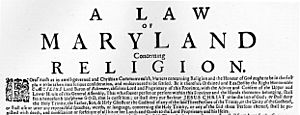Plundering Time facts for kids
Quick facts for kids Plundering Time |
|||||||
|---|---|---|---|---|---|---|---|
| Part of English Civil War and Protestant Revolution of Maryland | |||||||
 William Claiborne, one of the infamous leaders, along with privateer Richard Ingle of the lawless period in the Province of Maryland known as the "Plundering Time" |
|||||||
|
|||||||
| Belligerents | |||||||
|
Maryland Catholics Maryland proprietary colonial militia |
Maryland Puritans outlaws |
||||||
| Commanders and leaders | |||||||
| Governor Lord Baltimore Leonard Calvert |
William Claiborne Richard Ingle |
||||||
| Strength | |||||||
| ? | ? | ||||||
| Casualties and losses | |||||||
| ? | ? | ||||||
The Plundering Time (1644–1646) was a period of trouble and lawlessness in the English colony of Province of Maryland. It was also known as "Claiborne and Ingle's Rebellion".
Contents
What Caused the Plundering Time?
Several things led to this period of unrest. One cause was a disagreement between William Claiborne and the Calvert family over who owned Kent Island, Maryland.
There were also strong tensions between the smaller group of Catholics who were in charge and the larger group of Protestants living in the colony. On top of this, political fights from the English Civil War back in England also played a part.
Events of the Plundering Time
In 1638, Leonard Calvert, who was the first governor of Maryland, took control of a trading post on Kent Island, Maryland. This post had been set up by William Claiborne.
In 1644, William Claiborne led an uprising of Protestants and took Kent Island back. At the same time, a privateer (a type of legal pirate) named Captain Richard Ingle took control of St. Mary's City, Maryland, which was the capital of the Maryland colony. The Catholic Governor Calvert had to escape to the Virginia Colony.
These Protestant privateers started taking property from anyone who did not support the English Parliament. This mostly affected Catholics in the colony.
How the Rebellion Ended
In 1647, the rebellion was finally stopped by Maryland Governor Lord Baltimore. He led Maryland's colonial forces against the Parliamentary privateers. He successfully regained control of the colony, which ended the rebellion started by Claiborne and Ingle.
Sadly, Lord Baltimore became ill and died the next summer in 1648.


What Happened After the Rebellion?
To help calm things down between the two groups, the Maryland colonial assembly passed the Maryland Toleration Act in 1649. This law aimed to allow religious freedom.
However, a victory for Parliament in England brought back old tensions. This led to another conflict called the Battle of the Severn in 1655, which took place near what is now Annapolis, Maryland.

